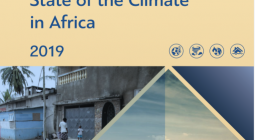Linking nitrous oxide to climate risk is yet another example of the disdain shown to women’s pain
When a new report suggested that people who use nitrous oxide when giving birth should be warned about the impacts on climate change, I felt the mild tremor of a collective groan uttered in unison across the country. More than one person sent me headlines accompanied by a rolling eye emoji.
Clearly the climate crisis is a pressing mattter of life or death and the future of all humanity. The staggering results of our federal election show that this is an issue about which Australians are deeply concerned. And many medical colleges are considering the effects of climate change on their patients, with the Australian Medical Association even issuing a call to arms.
I spend my days examining issues of women’s health and medical care. Given the minuscule effect on the environment that nitrous – also known as laughing gas – has, I feel that this report and its positioning by the Australian and New Zealand College of Anaesthetists was seriously misguided.
The are about 300,000 live births a year in Australia. Figures showing nitrous usage were only provided from one hospital in the press release, so we have no way of knowing whether they’re widely indicative, but they showed that 62% of patients used nitrous during labour. If 62% of births include use of nitrous, that is 186,000 parents. That sounds like a lot, but is it? Is it enough to make a meaningful difference to climate change?
“While it’s appropriate for the sector as a whole to examine its greenhouse gas emissions and seek ways to get them down, we have to remember that the core of the climate crisis is the burning of coal, oil and gas for energy,” the Climate Council’s senior researcher for climate solutions, Tim Baxter, told me.
“At planetary scale, the relative impact of nitrous oxide use in labour wards isn’t irrelevant, but it is very, very small. No individual mother should be made to feel guilty about her choice of pain relief. At an individual scale, parents could do more to protect their child’s health, their wallets and the climate by doing simple things like getting gas out of their homes.”
A glaring omission is the use of nitrous in dentistry, for which it is much more well-known. Prof Ian Meyers OAM is the president of the Royal Australasian College of Dental Surgeons. He told me nitrous is mostly used to alleviate fear and anxiety in children but it is used more broadly too.
So why this this report? Why now? Why this issue above all others? Why the omission of other uses? Why did I get all those rolling eye emoji text messages?
We know, and have known for some time, that pain among women is not taken as seriously, even when they are having the same procedures as men. One study showed that women who had heart bypass surgery were only half as likely as men to be prescribed painkillers after that procedure. They also wait longer to receive analgesia in emergency rooms.
Nitrous oxide is one of the lowest-risk options available to birthing parents who want some mild pain relief or are fearful going into birth and need to calm anxiety. It is also very low risk for the babies. Given that it’s used in such small numbers, for short(ish) durations and its minimal effect on global warming, you just wonder why this issue was raised at all.
It was excruciating. It was like something from the middle ages
Any parent knows the judgment surrounding giving birth is can be overwhelming. Throughout the last decade parents have been pushed towards “normal” or “natural” births, in some cases with dire consequences.
For those who don’t want to have an epidural or morphine, the report’s authors suggested transcutaneous electric nerve stimulators (Tens), hypnobirthing and massage as alternatives to nitrous. The idea that most parents can afford a Tens machine, hynobirthing classes or massage is laughable.
I don’t see anyone asking men queuing up from colonoscopies or transurethral resections of the prostate to give a Tens machine or massage a go. They’re knocked out quicker than you can say “bob’s your uncle”.
While interviewing a patient in Western Australia, it came to my attention that there is a growing movement in Australia to follow a UK trend (which took root mainly as part of NHS cost-cutting measures) to conduct all hysteroscopies with no pain relief at all.
A hysteroscopy is an examination of the inside of the uterus, during which a doctor may remove polyps or fibroid tumours from the uterine wall. The patient I interviewed to was told by the public hospital treating her that “85% of patients get through it OK”. What about the other 15%? Well they don’t make it though to the end due to the pain, apparently.
The patient I spoke to waited seven months to have the procedure. She was told she could have anaesthesia but that she would have to go back on the waiting list for an undefined period to wait for an anaesthetist, while living with the associated chronic pain caused by her submucosal fibroid. She was convinced to go ahead without anaesthetic.
“It was excruciating,” she told me. “It was like something from the middle ages, like, but by the time they’re doing it you, just like let’s just get it over with. It lasted a really long time. My body was just convulsing with pain. It was it was absolutely horrific.”
In the UK, this trend led to the founding of a campaign group called Campaign Against Painful Hysteroscopy and a petition called “End barbaric NHS hysteroscopies with inadequate pain-relief” which had attracted almost 57,000 signatures at the time of writing.
I see little to no research or discussion of this or the risks to non-male patients by a system that doesn’t take their pain properly, doesn’t believe them when they present at emergency rooms with life-threatening conditions like heart attacks or pressuring them into “natural” births because it’s more convenient and cheaper for the hospital, but simply not what the parent wants.
While the report in itself may not be “incorrect” in any way, it feels like the lowest hanging, cheap-as-chips fruit. Context is everything and, in a world where people who aren’t men are fighting for their right to be treated with care, equality and compassion, the release of this report in this way was deeply ill-advised and made for painful reading.
-
Isabelle Oderberg is a journalist and media professional and is writing her first book on the topic of miscarriage and early pregnancy loss
Isabelle Oderberg | Guardian





